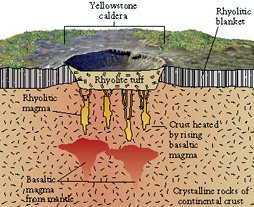
Yellowstone National Park sits on a high plateau supported by a hot mantle plume. This so-called hotspot has been the site of three caldera-forming eruptions in the last two million years. The last eruption, ~630,000 years ago, generated ~1000 km3 of pyroclastic sheet flows and airfall tephra which fell as far away as Louisiana. The Yellowstone calderas are part of a southwest-trending, linear system of calderas that becomes progressively older from Yellowstone through the Snake River Plain of Idaho, to the 17-million-year-old McDermitt Caldera along the Oregon-Idaho border. Most of the calderas in Idaho are covered with younger basaltic lavas associated with the Snake River Plain. This appears to be one of the few continental examples of a hotspot track, similar to the oceanic hotspot track of the Hawaiian and Emporer seamount chains.
The caldera-forming rhyolite eruptions along the hotspot track, and the basalt eruptions along the Snake River Plain, clearly are derived from seperate sources. The basaltic melts are partial melts from the mantle and the rhyolitic melts are partial melts of continental crust. The mantle plume that currently exists beneath Yellowstone generated hot basalt magmas at depth, which ascended into the lower crust where they melted continental crust to produce the rhyolitic magmas. These rhyolite melts then ponded beneath the Yellowstone region, in a shallow magma chamber that generating doming and the development of ring fractures on the Yellowstone surface. Explosive volcanism above this elevated and fractured dome began about 630,000 years ago, and collapse of the structure soon followed.
 |
Yellowstone Caldera -- The ascent of hotspot-generated basaltic magmas results in melting of the continental crust to produce rhyolitic magmas. These gas-rich felsic magmas pond at shallow levels and erupt along ring fractures. The caldera is formed due to piston-like collapse of the magma chamber roof after the rhyolitic magma chambers are partially depleted. Courtesy of John Wiley and Sons. |
Two resurgent domes currently occupy the caldera floor -- the Mallard Lake dome to the west and the Sour Creek dome to the east. Resurgence has been associated with the intermittent extrusion of largely degassed rhyolitic lavas, most of which have erupted over the last 150,000 years.